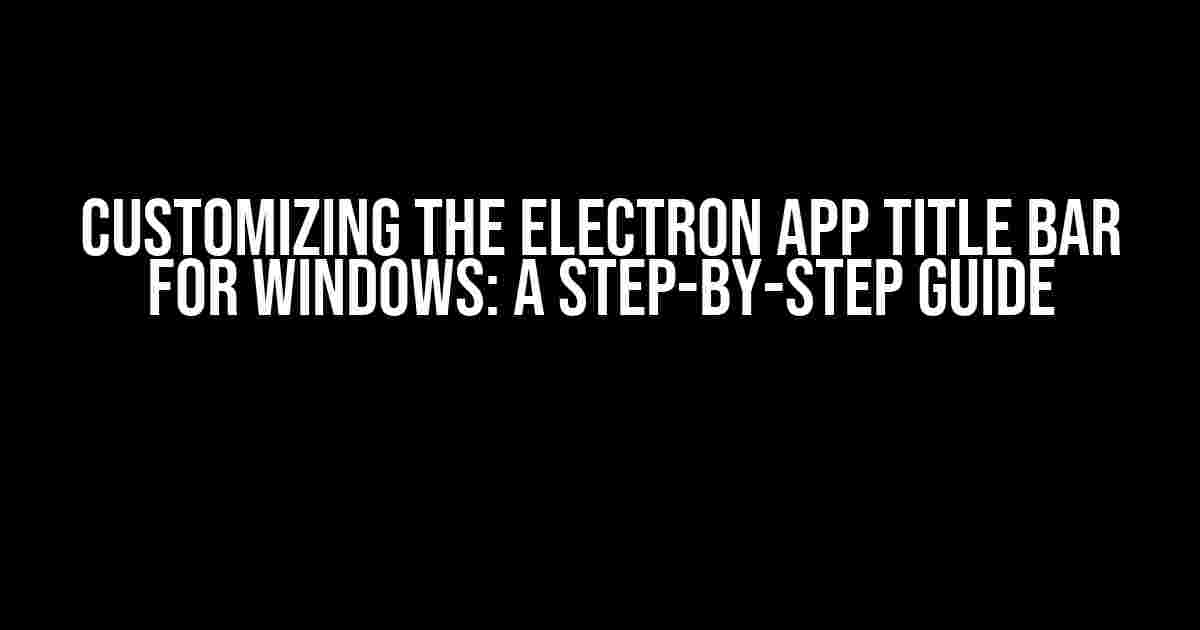When building Electron apps, the title bar is often an afterthought. But why settle for the default when you can create a custom title bar that reflects your app’s brand and style? In this article, we’ll show you how to customize the Electron app title bar for Windows, complete with minimal details such as a logo, name, minimize, maximize, and close buttons.
Understanding the Default Title Bar
Before we dive into customization, let’s take a look at the default title bar provided by Electron. By default, the title bar includes the app’s name, a minimize button, a maximize button, and a close button. It’s a simple yet functional design, but it may not align with your app’s visual identity.
The Title Bar Components
The default title bar consists of the following components:
- The app’s name (or title)
- A minimize button (−)
- A maximize button ()
- A close button (×)
Customizing the Title Bar
To customize the title bar, we’ll need to use Electron’s BrowserWindow API and a combination of HTML, CSS, and JavaScript. Let’s get started!
Step 1: Create a Custom Title Bar HTML
Create a new HTML file (e.g., title-bar.html) and add the following code:
<div class="title-bar">
<img src="logo.png" alt="App Logo" class="logo">
<span class="title">My App</span>
<div class="buttons">
<button class="minimize">−</button>
<button class="maximize">></button>
<button class="close">×</button>
</div>
</div>
This code creates a custom title bar with a logo, app title, and three buttons (minimize, maximize, and close).
Step 2: Add CSS Styles
Create a new CSS file (e.g., title-bar.css) and add the following styles:
.title-bar {
background-color: #333;
color: #fff;
padding: 10px;
display: flex;
align-items: center;
justify-content: space-between;
}
.logo {
width: 20px;
height: 20px;
margin-right: 10px;
}
.title {
font-size: 16px;
font-weight: bold;
}
.buttons {
display: flex;
align-items: center;
}
.minimize, .maximize, .close {
background-color: transparent;
border: none;
padding: 10px;
font-size: 16px;
cursor: pointer;
}
.minimize:hover, .maximize:hover, .close:hover {
background-color: #444;
}
These styles give our custom title bar a sleek and modern look. You can adjust the colors, padding, and font sizes to fit your app’s brand.
Step 3: Add JavaScript Logic
Create a new JavaScript file (e.g., main.js) and add the following code:
const { app, BrowserWindow } = require('electron');
let win;
app.on('ready', () => {
win = new BrowserWindow({
width: 800,
height: 600,
titleBarStyle: 'custom',
titleBarOverlay: true,
webPreferences: {
nodeIntegration: true
}
});
win.loadURL(`file://${__dirname}/index.html`);
// Add event listeners for minimize, maximize, and close buttons
document.getElementById('minimize').addEventListener('click', () => {
win.minimize();
});
document.getElementById('maximize').addEventListener('click', () => {
win.maximize();
});
document.getElementById('close').addEventListener('click', () => {
win.close();
});
});
app.on('window-all-closed', () => {
app.quit();
});
This code creates a new BrowserWindow instance with a custom title bar, loads the index.html file, and adds event listeners for the minimize, maximize, and close buttons.
Step 4: Add Title Bar HTML to the BrowserWindow
In your index.html file, add the following code:
<body>
<div id="title-bar">
<!-- Include the title-bar.html file here -->
<iframe src="title-bar.html" frameborder="0" width="100%" height="30" scrolling="no"></iframe>
</div>
</body>
This code adds the custom title bar HTML to the BrowserWindow instance.
Putting it all Together
Now that we’ve completed the steps, let’s see the final result:
| This is what our custom title bar looks like with a logo, app title, and three buttons (minimize, maximize, and close). |
We’ve successfully customized the Electron app title bar for Windows, complete with a logo, app title, and three buttons (minimize, maximize, and close). You can further customize the styles and logic to fit your app’s unique requirements.
Conclusion
Customizing the Electron app title bar for Windows is a straightforward process that requires minimal coding. By following these steps, you can create a custom title bar that reflects your app’s brand and style. Remember to experiment with different styles, colors, and layouts to make your app stand out.
If you have any questions or need further assistance, feel free to ask in the comments below.
Happy coding!
Frequently Asked Question
Get the scoop on customizing the Electron App title bar for Windows, and take your app to the next level!
How do I customize the Electron App title bar for Windows?
To customize the Electron App title bar for Windows, you can use the `BrowserWindow` API’s `setWindowTitle` method to set the title of the window, and the `setWindowIcon` method to set the icon. You can also use CSS to style the title bar and add your own custom elements.
How can I add a logo to the title bar of my Electron App?
To add a logo to the title bar of your Electron App, you can create an `` element and append it to the title bar using the `BrowserWindow` API’s `getTitleBar()` method. You can then style the logo using CSS.
How can I customize the minimize, maximize, and close buttons on the title bar?
To customize the minimize, maximize, and close buttons on the title bar, you can use the `BrowserWindow` API’s `setWindowButtonVisibility` method to hide or show the buttons, and the `setWindowButtonEnabled` method to enable or disable them. You can also use CSS to style the buttons and add your own custom behavior.
Can I use a custom title bar template for my Electron App?
Yes, you can use a custom title bar template for your Electron App by creating a custom HTML template and appending it to the title bar using the `BrowserWindow` API’s `getTitleBar()` method. You can then style the template using CSS and add your own custom functionality.
What are some best practices for customizing the Electron App title bar for Windows?
Some best practices for customizing the Electron App title bar for Windows include keeping the design consistent with Windows native apps, using clear and concise labels, and ensuring that the title bar is accessible and usable for all users. You should also test your title bar customization on different versions of Windows and Electron to ensure compatibility.
